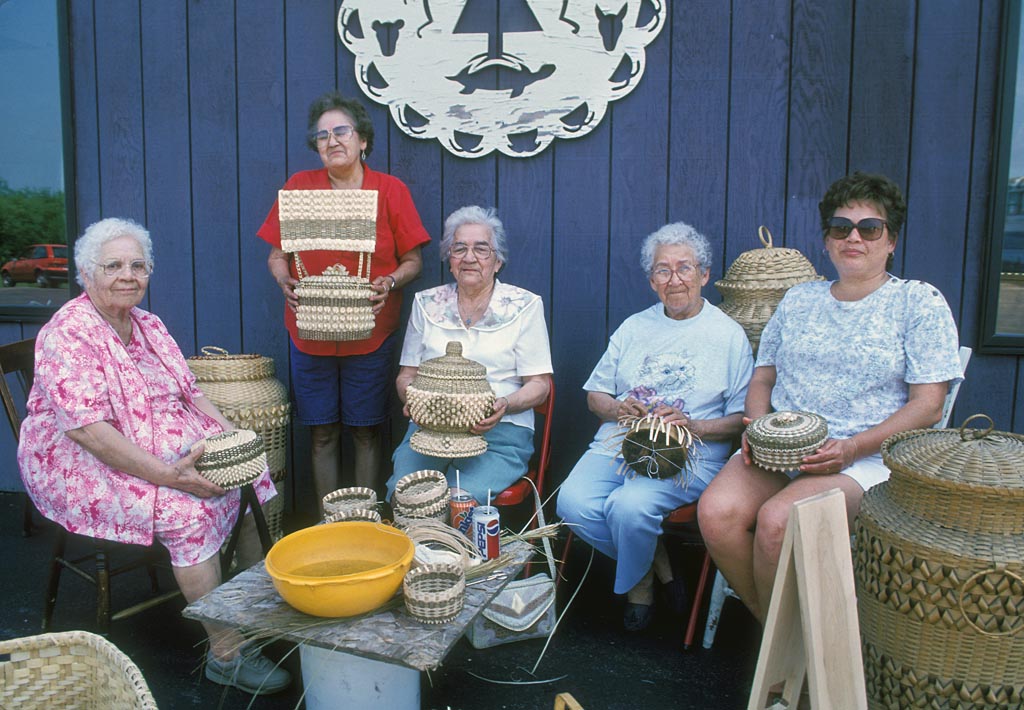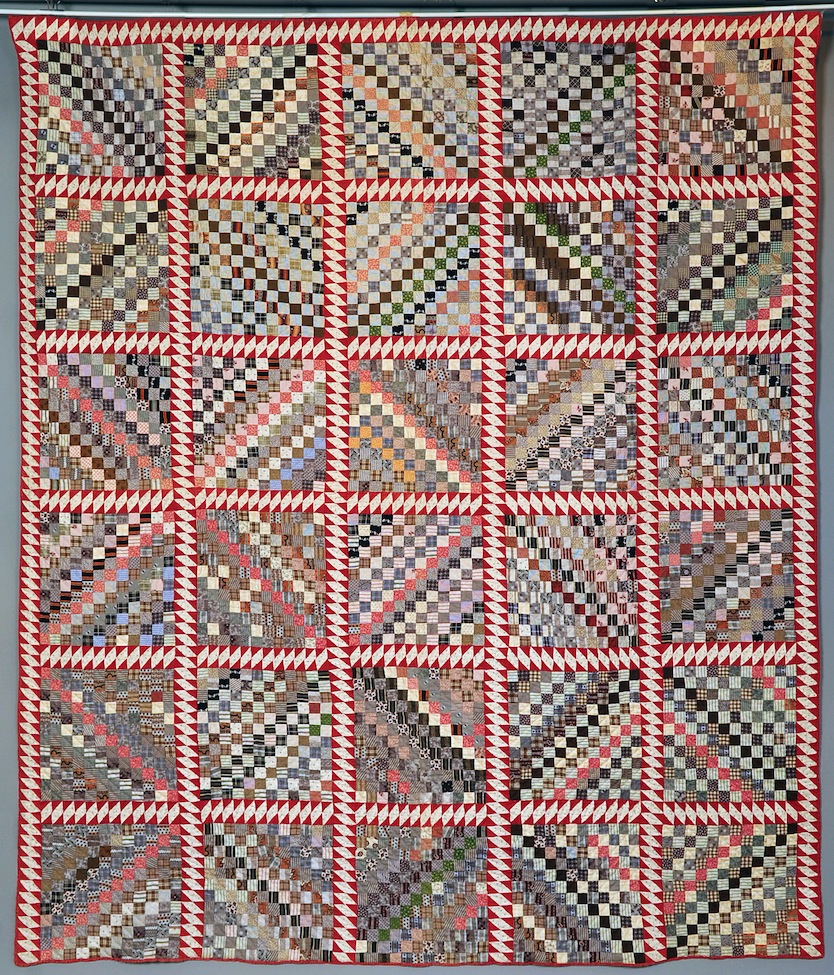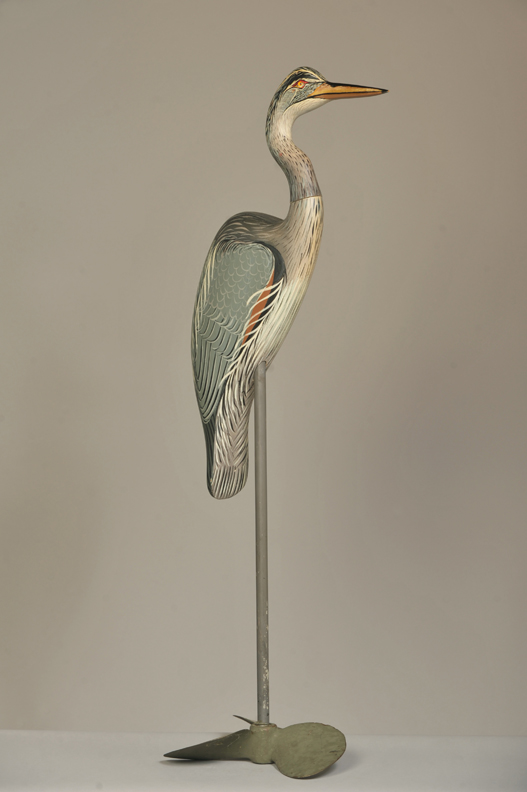Virtuosity:
Demonstrating Craftsmanship
 Some
artists and their communities take great pride in the mastery of
complex skills needed to create their traditional art forms. Some have worked for years under the tutelage of a master artist; others may be self taught.
Some
artists and their communities take great pride in the mastery of
complex skills needed to create their traditional art forms. Some have worked for years under the tutelage of a master artist; others may be self taught.
All place great emphasis on workmanship and quality. Good tools, good materials, time, and patience are prerequisites.
Case Study
Akwesasne Basket Makers
Mohawks at Akwesasne are renowned for their ash splint and sweetgrass baskets. Prized through the generations as much for their fragrance as for their usefulness and fine quality, most of the baskets have been conventional in form and decoration, made primarily to satisfy the demands of collectors and the souvenir trade.
A few of the women at Akwesasne are recognized within the community as “the best,” and have been instrumental in teaching the art to the younger generations. Their skills in preparing and weaving the splints and grass have been learned and passed along in their families and community.
In recent years, some of these women—proclaimed as “artists” by writers and galleries elsewhere—have been experimenting with innovative designs and new techniques. Today, examples of their work are represented in major collections, including the Smithsonian Institution and the Vatican.
Mohawk Sweetgrass BasketsThese four “fancy baskets” illustrate the continuity and change of black ash splint and sweetgrass basket making at Akwesasne since the late 19th century. Typically, men cut the trees and pound the logs to create splints; women gather wild sweetgrass, clean and dry it, and sometimes braid it into narrow rope. According to the Iroquois Indian Museum, “The splints are made thinner initially by splitting the top of the splint with a knife and then pulling it apart. The thin splints must then be smoothed and cut to size for weaving. If a basket is to be colorful, splints must at this point be dyed.... Once these materials are gathered and prepared, the basket is ready to be woven. Various weaves are employed. The tightness and evenness of the weave contribute to a well-made basket.”
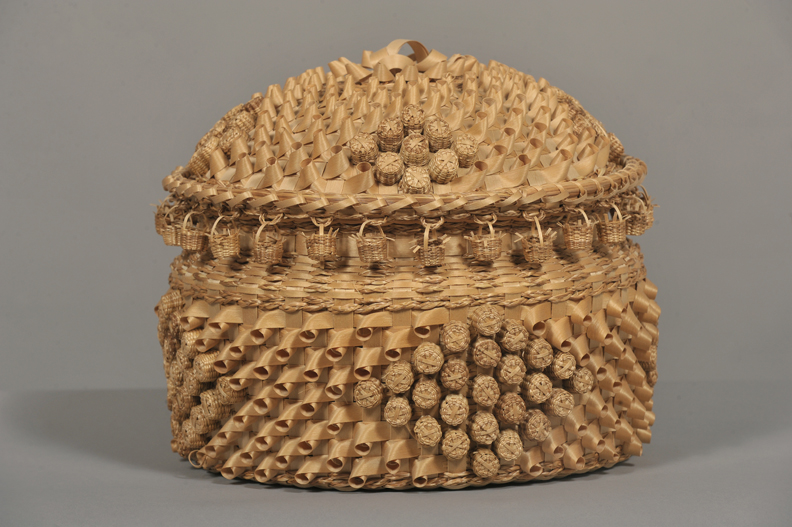
Pope’s Basket
Mary Adams, Akwesasne, ca. 1980
Courtesy of Akwesasne Museum
This basket was created by Mary Adams in anticipation of a group trip to Rome and an audience with Pope John Paul II. A devout Catholic, Adams wanted to make the best basket she could for the occasion. She wove 167 finger-tip size baskets to apply to the splint surface in diamond patterns, with a fringe lining the lid, a spectacular use of materials and design ideas. Adams eventually made several of these baskets, one of which is now in a collection at the Smithsonian.
Inverted Weaving Basket
Josephine Delormier, Akwesasne, date unknown
Courtesy of Akwesasne Museum
Woven and Dyed Basket
Shirley Thompson, Akwesasne, 2011
Courtesy of Akwesasne Museum
Trio of Pineapple Weave Baskets
Denise Jock, Akwesasne, 2011
Courtesy of Akwesasne Museum
Postage Stamp Quilt
Elsie Barnes Patterson, Morley, ca. 1880s
Courtesy of the Town & Village of Canton Historical Collection
This full-sized quilt top is made of 7,834 one-inch square pieces of fabric. The colors were carefully selected for an overall optical effect, giving it a contemporary appearance. Such bedcovers were rarely quilted, stitched only in the outside border and the dividing bands.
The Beautiful and the Terrible:
St. George and the Dragon Penmanship Drawing
Helen M. Durand, Elizabethtown, 1858
Courtesy of Adirondack History Center Museum
 The "Golden Age of Ornamental Penmanship," from 1850 to 1925, was a unique period in American calligraphic history. Beautiful penmanship was the rule of the day. Drawing elaborate pictures with a pen was, as this early example shows, encouraged by writing teachers to practice hand and wrist motion and to provide entertainment. The inscription at the bottom of this drawing reads: “This piece of Penmanship King George and the Dragon was Executed with a Steel without a coppy [sic] by H. M. Durand in 5 weeks and 5 days August 25 1858.”
The "Golden Age of Ornamental Penmanship," from 1850 to 1925, was a unique period in American calligraphic history. Beautiful penmanship was the rule of the day. Drawing elaborate pictures with a pen was, as this early example shows, encouraged by writing teachers to practice hand and wrist motion and to provide entertainment. The inscription at the bottom of this drawing reads: “This piece of Penmanship King George and the Dragon was Executed with a Steel without a coppy [sic] by H. M. Durand in 5 weeks and 5 days August 25 1858.”
St. Lawrence River Skiff Model
James Kincaid, Wellesley Island, 2007
Courtesy of Allan P. Newell
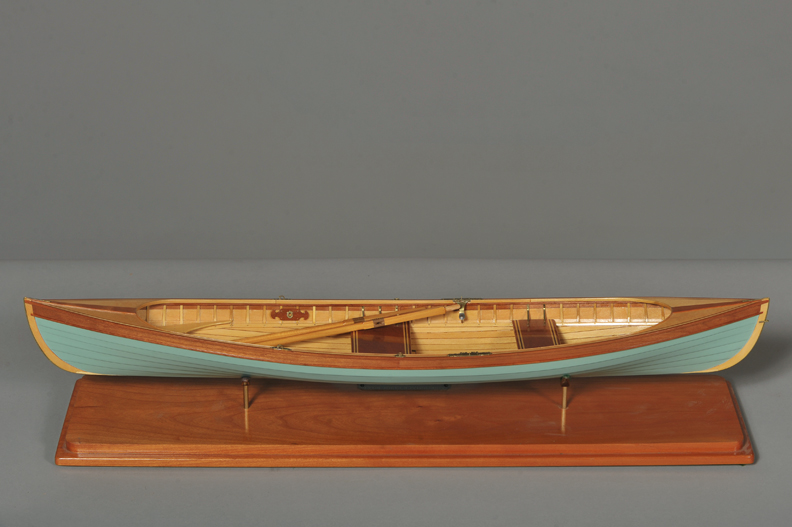 In the North Country, where small wooden pulling boats—canoes, rowboats, guideboats, and St. Lawrence skiffs—have been a large part of local life, making model boats has been a popular pastime, too. Mechanical engineer Jim Kincaid, who summered on the St. Lawrence all his life, demonstrated great precision and attention to detail in his models, some taking as long as a year to complete.
In the North Country, where small wooden pulling boats—canoes, rowboats, guideboats, and St. Lawrence skiffs—have been a large part of local life, making model boats has been a popular pastime, too. Mechanical engineer Jim Kincaid, who summered on the St. Lawrence all his life, demonstrated great precision and attention to detail in his models, some taking as long as a year to complete.
Blue Heron Decoy
Roy Conklin, Alexandria Bay, ca. 1940s
Courtesy of Allan P. Newell
As early as the late 1920s, some decoy carvers began to experiment with carving and painting birds intended for decoration only. With their knowledge of the birds’ anatomies and habits and their considerable skill in carving and painting, they would sometimes make special pieces as gifts or to fill orders from vacationers who recognized their talents. Roy Conklin was considered one of the most innovative decoy makers, particularly known for his fine painting. This blue heron is a good example of his skills.
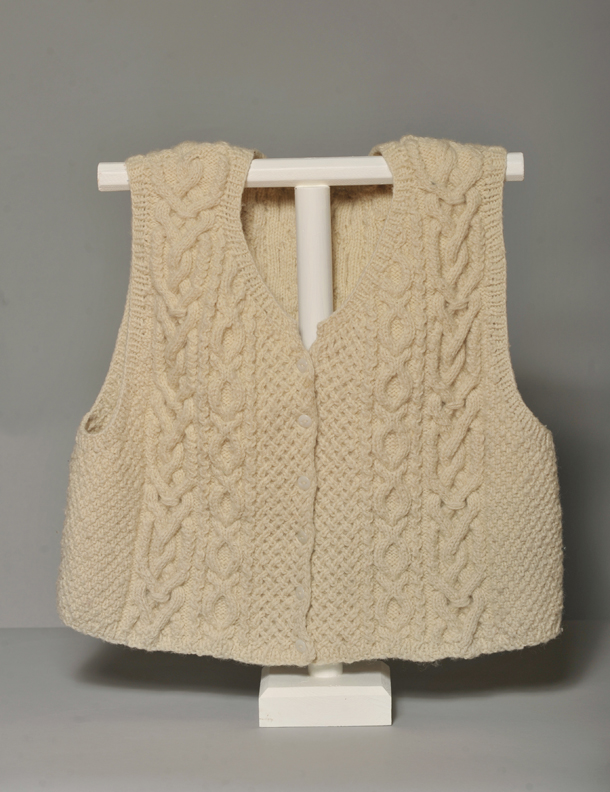
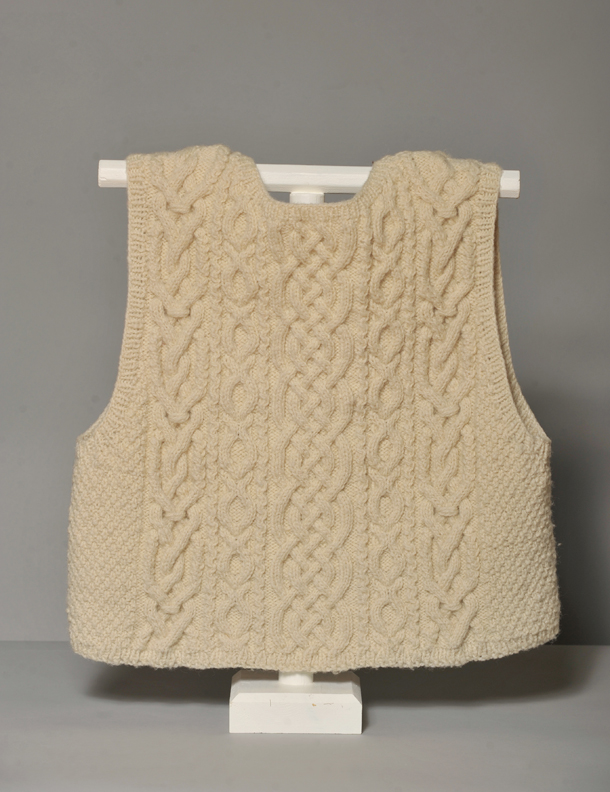 Adonis’s Aran Isle Vest
Adonis’s Aran Isle Vest
Lamar Bliss, Potsdam, ca. 1995
Courtesy of the artist
The Aran sweater, sometimes called a fisherman’s sweater, takes its name from the Aran Islands off the west coast of Ireland. A classic fisherman's sweater is a bulky garment, often cream-colored with prominent raised cable patterns on the chest and back. Lamar Bliss is an accomplished knitter who spins the wool for her projects from sheep she raises. As is typical of Aran knitting, Bliss made this vest from wool from Adonis, a favorite among her early sheep. Creating her own design for this vest, Bliss combined several conventional stitches, including cables, ropes, and seed. She enjoys the Aran style, as figuring out a pattern is mathematical and knitting is sculptural,“like knitting in 3-D.”
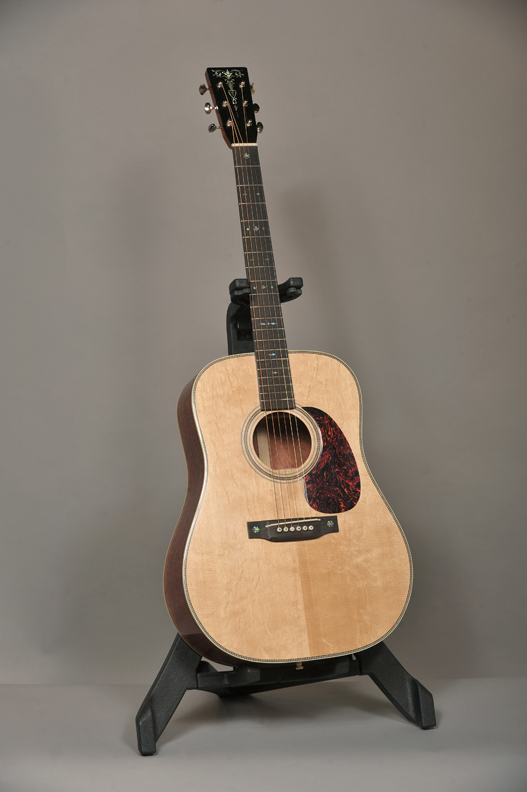
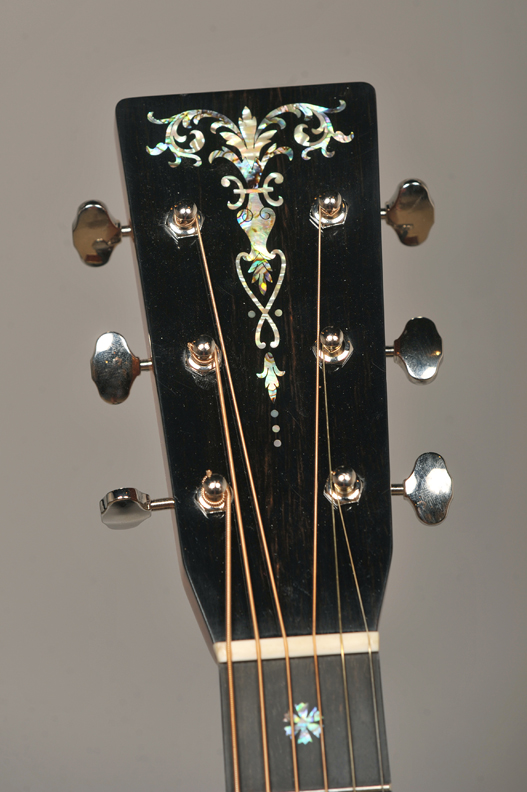 Custom Inlaid Guitar
Custom Inlaid Guitar
David Nichols, Whippleville, 2011
Courtesy of the artist
While stringed musical instruments—violins, guitars, banjos, and mandolins—have long been popular in the region, most have been rather ordinary in appearance compared to some made by David Nichols. From selecting, shaping, and finishing exotic woods to cutting and fitting mother-of-pearl or abalone inlay, Nichols’ skills have been recognized by string players far and wide. If you pick up a decorated Martin or Gibson guitar made since the late 1960s, it’s apt to be his work. This guitar is a good example of the variety of woods he uses and the quality of his inlay work.
Iroquois Confederacy Pendant
Julius Cook, Akwesasne, 1980s
Courtesy of Elda Cook
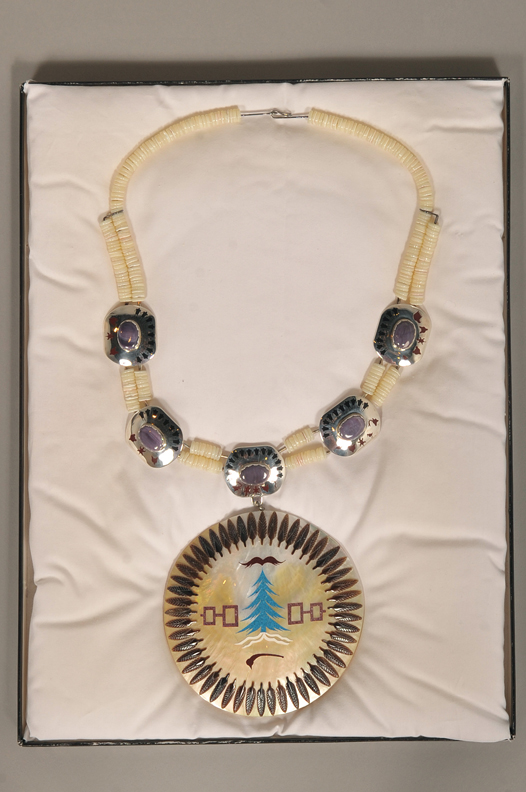 Julius Cook was an expert high steel worker and foreman on big projects like the 1964 World’s Fair Unisphere and the World Trade Center. He was also devoted to the longhouse tradition and to studying his culture, and he revived the ancient craft of Iroquois silversmithing. This pendant shows how skillful he became in blending both interests. According to his son Ray: “The feathers in the circle represent the 50 Confederacy Chiefs that sit in Council in a circle under the Great Tree of Peace. The war club is placed in an underground stream beneath the tree, symbolizing the peace that comes with joining the Confederacy, no war among members. The roots spread to the four directions around the world. The eagle stands guard atop the tree, staying on the lookout for any threats that may come our way.
Julius Cook was an expert high steel worker and foreman on big projects like the 1964 World’s Fair Unisphere and the World Trade Center. He was also devoted to the longhouse tradition and to studying his culture, and he revived the ancient craft of Iroquois silversmithing. This pendant shows how skillful he became in blending both interests. According to his son Ray: “The feathers in the circle represent the 50 Confederacy Chiefs that sit in Council in a circle under the Great Tree of Peace. The war club is placed in an underground stream beneath the tree, symbolizing the peace that comes with joining the Confederacy, no war among members. The roots spread to the four directions around the world. The eagle stands guard atop the tree, staying on the lookout for any threats that may come our way.








